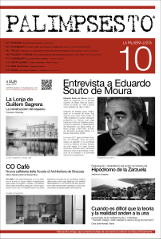La Lonja by Guillem Sagrera. The construction of the space
DOI:
https://doi.org/10.5821/palimpsesto.10.3655Keywords:
Lonja, Sagrera, MallorcaAbstract
To understand La Lonja is to understand the beginnings of themodern times. The epoch of the dual power of kings and bishopsand the buildings whose construction lasted centuriesis over. A new group comes in and will accompany the arts upthe early twentieth century. They are merchants and traderswho became strong during the thirteenth and fourteenth centuriesand now wish to belong to the Kingdom’s governmentand have a building that would represent them.
La Lonja de Mallorca is a fifteenth-century building located inCiutat de Mallorca in the Raval de Mar, an old neighborhoodoutside the walls. The author of the building, Guillem Sagrera,pertains to the generation of artists born in the late fourteenthcentury, who started to work at the end of an epoch and developeda new way of building.
These artists learned all trades related to construction of thefourteenth century, but worked under the new conditions ofthe fifteenth century. They knew the geology, the work and thesize of the stone quarries, their transportation, how to buildwooden formwork for construction of vaults, how to lift these,and many other things.
La Lonja of the College of Merchants will be not merely thenew building for this trade, but a new way of building the cityand perceive the interior space.
Downloads
Published
Issue
Section
License
PROTECTION AND INTELLECTUAL PROPERTY CRITERIA
Authors whose work is published in en Palimpsesto agree to the following terms:
1. The author retains the copyrights and guarantees the magazine the right to apply a Creative Commons Attribution-NonCommercial-NoDerivatives (CC BY-NC-ND), which permits others to share the work with acknowledgement of authorship.
2. The author may establish additional agreements of his or her own accord for non-exclusive distribution of the article published in the magazine (for example, in an institutional repository, or published in a book).
3. Electronic distribution of the work by the author(s) is permitted and encouraged (for example, in institutional repositories or on the author’s own website), prior to, and during the submission process, as this can generate productive exchanges, as well as earlier and greater citation of the published works (see The Effect of Open Access) (in English).
4. The author or provider of the material submitted for publication authorizes Palimpsesto to publish, with no obligation whatsoever (financial or otherwise) to the content of said material, be it in paper or digital format, or in any other medium.
5. The author or provider guarantees that he or she is the owner of the Intellectual Property rights to the contents provided, which encompasses the text and images/photographs/photographic works incorporated in the article.
6. The author or provider, exempts Palimpsesto magazine of all and any responsibility relating to violation of copyrights, thereby committing himself or herself to undertaking all efforts to assist Palimpsesto magazine in defence of any accusation, extra-judiciary, and/or judicial measures. Likewise, the author or provider will assume payment to Palimpsesto of any sum or compensation that must be paid to third parties for failure to comply with these obligations, be it the result of judicial, arbitrary or administrative decisions.
7. The submission of the texts by authors implies automatically a declaration of non plagiarism of its contents







